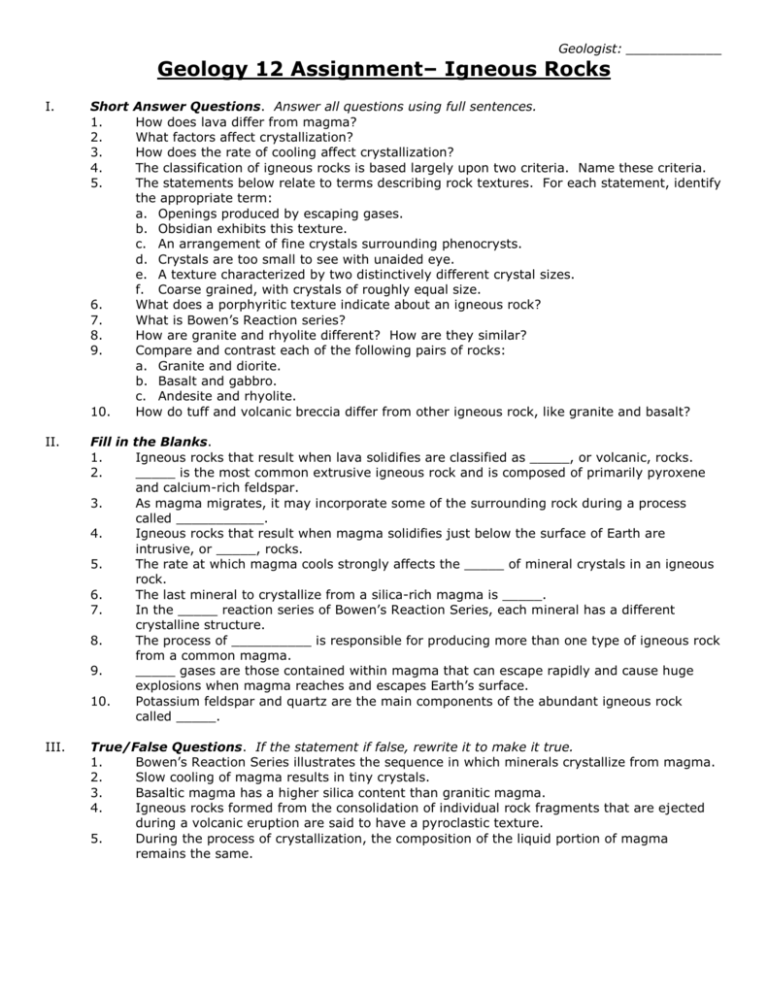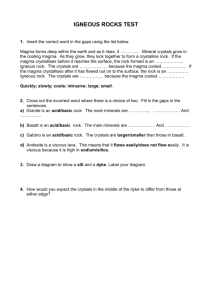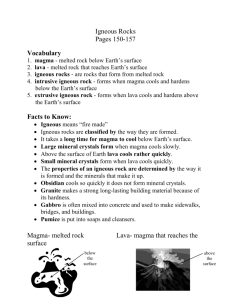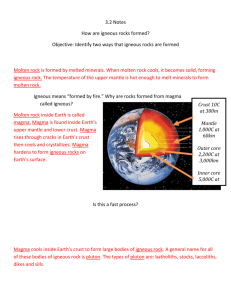assignment_05_igneou..
advertisement

Geologist: ____________ Geology 12 Assignment– Igneous Rocks I. Short 1. 2. 3. 4. 5. 6. 7. 8. 9. 10. Answer Questions. Answer all questions using full sentences. How does lava differ from magma? What factors affect crystallization? How does the rate of cooling affect crystallization? The classification of igneous rocks is based largely upon two criteria. Name these criteria. The statements below relate to terms describing rock textures. For each statement, identify the appropriate term: a. Openings produced by escaping gases. b. Obsidian exhibits this texture. c. An arrangement of fine crystals surrounding phenocrysts. d. Crystals are too small to see with unaided eye. e. A texture characterized by two distinctively different crystal sizes. f. Coarse grained, with crystals of roughly equal size. What does a porphyritic texture indicate about an igneous rock? What is Bowen’s Reaction series? How are granite and rhyolite different? How are they similar? Compare and contrast each of the following pairs of rocks: a. Granite and diorite. b. Basalt and gabbro. c. Andesite and rhyolite. How do tuff and volcanic breccia differ from other igneous rock, like granite and basalt? II. Fill in the Blanks. 1. Igneous rocks that result when lava solidifies are classified as _____, or volcanic, rocks. 2. _____ is the most common extrusive igneous rock and is composed of primarily pyroxene and calcium-rich feldspar. 3. As magma migrates, it may incorporate some of the surrounding rock during a process called ___________. 4. Igneous rocks that result when magma solidifies just below the surface of Earth are intrusive, or _____, rocks. 5. The rate at which magma cools strongly affects the _____ of mineral crystals in an igneous rock. 6. The last mineral to crystallize from a silica-rich magma is _____. 7. In the _____ reaction series of Bowen’s Reaction Series, each mineral has a different crystalline structure. 8. The process of __________ is responsible for producing more than one type of igneous rock from a common magma. 9. _____ gases are those contained within magma that can escape rapidly and cause huge explosions when magma reaches and escapes Earth’s surface. 10. Potassium feldspar and quartz are the main components of the abundant igneous rock called _____. III. True/False Questions. If the statement if false, rewrite it to make it true. 1. Bowen’s Reaction Series illustrates the sequence in which minerals crystallize from magma. 2. Slow cooling of magma results in tiny crystals. 3. Basaltic magma has a higher silica content than granitic magma. 4. Igneous rocks formed from the consolidation of individual rock fragments that are ejected during a volcanic eruption are said to have a pyroclastic texture. 5. During the process of crystallization, the composition of the liquid portion of magma remains the same.








